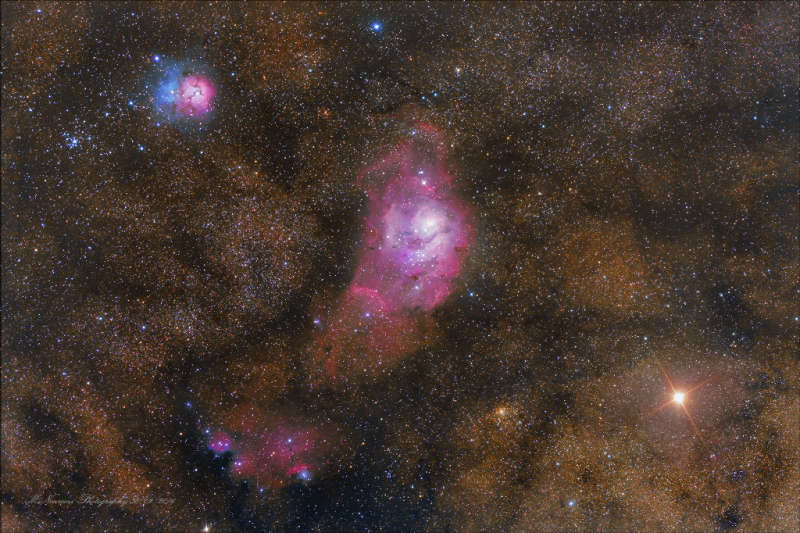Credit & Copyright: Mohammad Nouroozi
Explanation:
Bright
nebulae and star clusters along this 5 degree
wide field of view are popular stops on telescopic tours
of the constellation Sagittarius and the crowded starfields of
the central Milky Way.
Cataloged by 18th century French
astronomer Charles Messier, M20, the colorful Trifid Nebula,
and M8, the expansive Lagoon Nebula, are at upper left and center.
Both are well-known
star forming regions about 5,000 light-years distant.
Just passing through the same
field of view on September 29,
the yellowish star lined up with M8 and M20 at the lower right is
actually Mars,
close to 8.8 light-minutes from Earth on that date.
That distance is nearly
equivalent
to 1 astronomical unit or the distance from Earth to Sun.
Mars is overexposed in the image,
with visible diffraction spikes created by the telescope mirror supports.
Of course, Mars has long been
known to wander through planet Earth's
night skies.
1999 2000 2001 2002 2003 2004 2005 2006 2007 2008 2009 2010 2011 2012 2013 2014 2015 2016 2017 2018 2019 2020 2021 2022 2023 2024 2025 |
Yanvar' Fevral' Mart Aprel' Mai Iyun' Iyul' Avgust Sentyabr' Oktyabr' Noyabr' Dekabr' |
NASA Web Site Statements, Warnings, and Disclaimers
NASA Official: Jay Norris. Specific rights apply.
A service of: LHEA at NASA / GSFC
& Michigan Tech. U.
|
Publikacii s klyuchevymi slovami:
Mars - M 20 - M 8 - Mars - Trehrazdel'naya tumannost' - Tumannost' Laguna
Publikacii so slovami: Mars - M 20 - M 8 - Mars - Trehrazdel'naya tumannost' - Tumannost' Laguna | |
Sm. takzhe:
Vse publikacii na tu zhe temu >> | |
